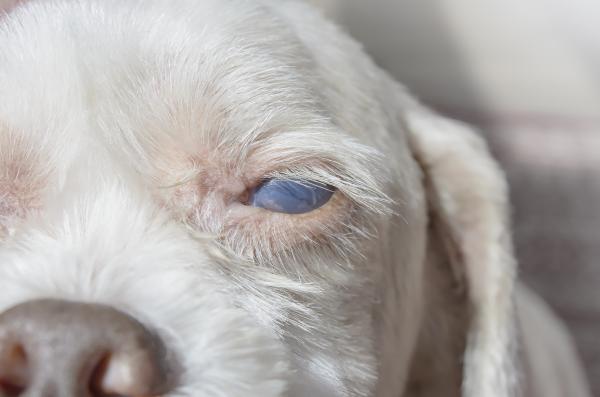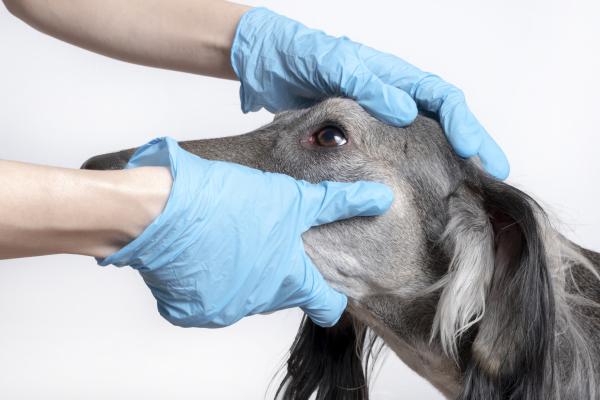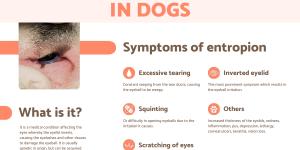Uveodermatologic Syndrome in Dogs - Causes and Treatment



See files for Dogs
Although most associated with the eye, uveodermatologic syndrome in dogs can affected various pigmented cells in the body and their corresponding tissues. This means it most commonly affects the skin and the eyes. It is an autoimmune condition which means their entire organism can also be affected. The symptoms of skin and eye discoloration are not necessarily problematic in themselves, but the immune-mediated nature of the syndrome means we need to take action if we notice any changes in our dog.
At AnimalWised, we discover more about uveodermatologic syndrome in dogs by looking at the most common causes and treatment. We also discover how it is diagnosed and what possible prevention methods are available.
What is uveodermatologic syndrome in dogs?
Uveodermatologic syndrome (UDS) is an autoimmune disease in dogs which affects pigment cells in their body. It is an inherited disorder, meaning there is a genetic component to its development. Fortunately, it is a relatively rare condition in dogs.
One way we can better understand uveodermatologic syndrome in dogs is to look at its corresponding disease in humans, a condition known as Vogt–Koyanagi–Harada disease (VKH). Both are multi-symptom conditions, meaning they do not refer to one issue, but a range of symptoms which constitute a syndrome. Although skin depigmentation of the lips, nose and eyes is one of the main symptoms, it is not the most worrying.
More problematic than depigmentation is the weakening of affected tissues in the eyes, ears and even the central nervous system. The disease itself does not directly threaten the wellbeing of the dog, but it associated with problems such as severe uveitis in dogs. This is the inflammation of the middle layer of the eye and a lack of treatment can result in blindness[1].
We better understand the effects of uveodermatologic syndrome in dogs by looking at its causes, symptoms and treatment in the next sections.
Causes of uveodermatologic syndrome in dogs
As stated above, uveodermatologic syndrome in dogs is a genetically inherited condition. Unlike an acquired disorder or disease, UDS does cannot develop from an environmental cause. Only dogs with the genetic predisposition will develop this syndrome.
Despite our knowledge that it is a genetic disorder, we do not know much about its specific etiology. Studies suggest uveodermatologic syndrome in dogs may be a result of an immune response against melanocytes[2]. These are the neural-crest cells which are responsible for producing melanin, so it is possible there is a relation to sun exposure, but this is yet to be confirmed.
Dog breeds associated with uveodermatologic syndrome
Since it is a genetically influenced immune-mediated disorder, uveodermatologic syndrome is more common in certain breeds[3]. These include the following:
- Akita Inu
- Siberian Husky
- Alaskan Malamute
- Samoyed
- Irish Setter
- Golden Retriever
- Old English Sheepdog
- St. Bernard
- Shetland Sheepdog
- Chow Chow
- Dachshund
There are other dog breeds predisposed to uveodermatologic syndrome, but to varying degrees.

Symptoms of uveodermatologic syndrome in dogs
As with any syndrome, there will be a range of symptoms which can affect a dog. Not all dogs with uveodermatologic syndrome will have the same symptoms. Since it is an immune-mediated disease which affects pigmented areas of the body, symptoms will appear in areas such as the skin, lips, nose and eyes. Discoloration of the dog's hair is often a result of immune-mediated conditions, although not always UDS.
The most common symptoms in canine patients are problems related to the eye[4]. We have already mentioned uveitis being a common concurrent problem with uveodermatologic syndrome, but other common canine eye diseases can develop. These include keratoconjunctivitis and keratitis in general, keratitis in dogs referring to a corneal inflammation.
With this in mind, we can find some of the most common symptoms of uveodermatologic syndrome in dogs:
- Aqueous flare (light scattering over the eyeball)
- Retinal detachment
- Iris abnormalities
- Glaucoma
- Skin depigmentation
- Vision loss
- Whitening of hair
- Vitiligo
- Light sensitivity
The symptoms an individual dog will develop will depend on various factors. As it is an immune-mediated condition, there may be times when there will be a flare up because the dog is stressed or has another reason for immunodepression. It may also appear when the dog is older and has a weakened immune system due to age.
Learn more about how a dog's immune system affects pigment with our article on vitiligo in dogs.
Uveodermatologic syndrome in dogs diagnosis
If we see any of the above symptoms, we need to take the dog to a veterinarian. Since these eye disorders can be caused by a range of issues, it will likely require a specialist to determine uveodermatologic syndrome, especially since it is a relatively rare disorder. The veterinarian may require a referral to a specialist such as a veterinary dermatologist or ophthalmologist. The veterinarian is more likely to suggest the possibility of UDS if there is significant squinting and the dog shows general signs of lowered immunity.
Uveodermatologic syndrome in dogs treatment
There are two main forms of treatment for UDS in dogs. Firstly, the symptoms will need to be treated. For example, if the problem is concurrent with uveitis, then we will need to control the inflammation and prevent blindness. This will require the use of topical medications such as cyclosporine and prednisolone for dogs.
Other eye problems will need to be managed. These may require anti-inflammatory medications to reduce swelling of the dog's eye, as well as antibiotics for any secondary infections. In some cases, surgical intervention may be required.
The other approach to treatment is to address the dog's immune system. This likely includes the use of long-term systemic immunosuppressive drugs. Glucocorticoids are the most common type used for this purpose in dogs and cats, but it will be your veterinarian who will determine the best option for your dog.
Discover more about one type of glucocorticoid used for ocular inflammation with our article on dexamethasone for dogs with swollen eyes.

Prevention of uveodermatologic syndrome in dogs
As it is a hereditary disorder, it is not possible to prevent uveodermatologic syndrome. If we have a dog breed which is predisposed to UDS or a mix of one of these breeds, we should be particularly vigilant if we see problems with their eyes or changes to their hair and skin coloration. We can help to prevent flare ups by taking good care of their immune system. This includes basic care such as proper diet, a positive home environment and meeting their specific exercise needs.

This article is purely informative. AnimalWised does not have the authority to prescribe any veterinary treatment or create a diagnosis. We invite you to take your pet to the veterinarian if they are suffering from any condition or pain.
If you want to read similar articles to Uveodermatologic Syndrome in Dogs - Causes and Treatment, we recommend you visit our Eye problems category.
1. Müller, R. S., Carr, A. P., & Hollingsworth, S. (1992). Das uveodermatologische Syndrom beim Hund [The uveodermatologic syndrome in dogs]. Tierarztliche Praxis, 20(6), 632–636.
https://pubmed.ncbi.nlm.nih.gov/1481221/
2. Angles, J. M., Famula, T. R., & Pedersen, N. C. (2005). Uveodermatologic (VKH-like) syndrome in American Akita dogs is associated with an increased frequency of DQA1*00201. Tissue antigens, 66(6), 656–665. https://doi.org/10.1111/j.1399-0039.2005.00508.x
3. Kang, M. H., Lim, C. Y., & Park, H. M. (2014). Uveodermatologic syndrome concurrent with keratoconjunctivitis sicca in a miniature poodle dog. The Canadian veterinary journal = La revue veterinaire canadienne, 55(6), 585–588.
https://www.ncbi.nlm.nih.gov/pmc/articles/PMC4022030/
4. Zarfoss, M. K., Tusler, C. A., Kass, P. H., Montgomery, K., Lim, C. C., Mowat, F., & Thomasy, S. M. (2018). Clinical findings and outcomes for dogs with uveodermatologic syndrome. Journal of the American Veterinary Medical Association, 252(10), 1263–1271.
https://doi.org/10.2460/javma.252.10.1263







